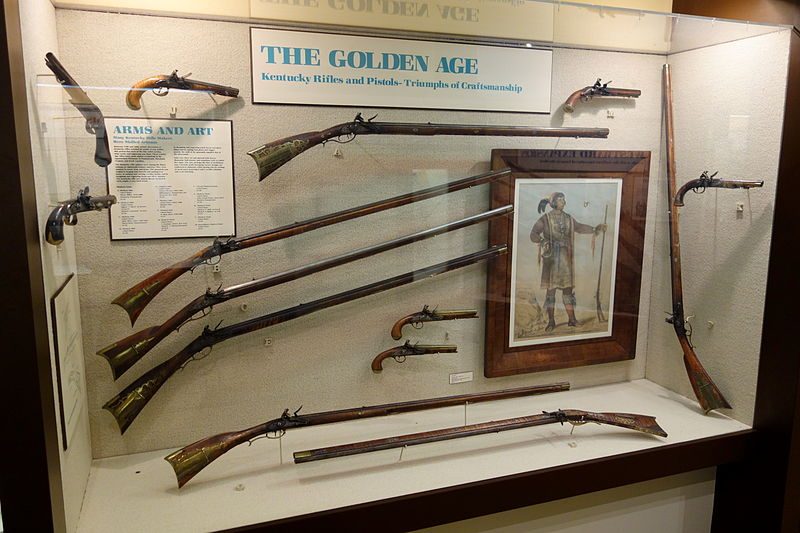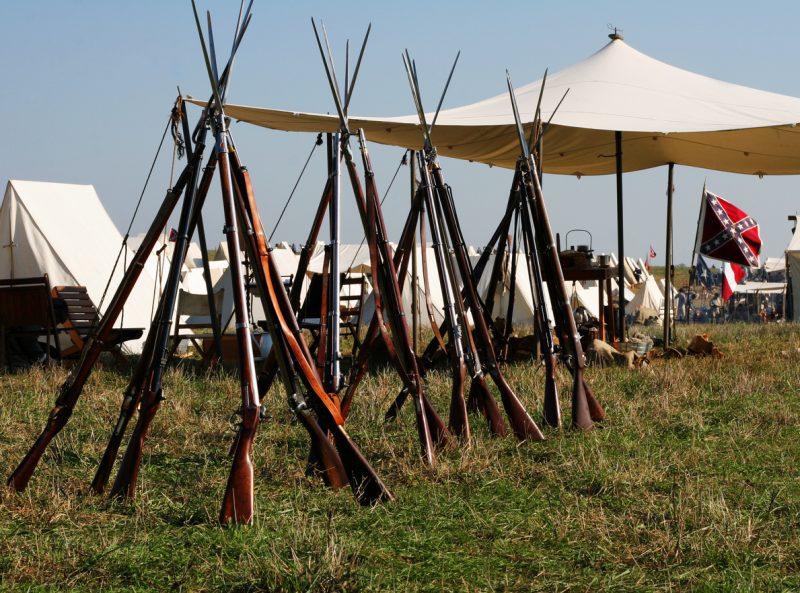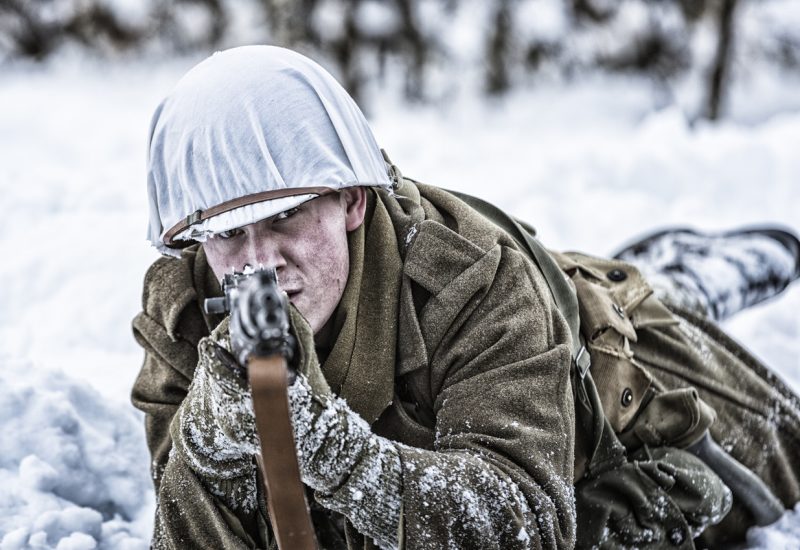What Made the Kentucky Rifle So Great?
Every once in a while, a weapon comes along that changes the course of history. The rock that Cain used to kill Abel was one of these. So was the Roman Gladius, the atomic bombs dropped on Nagasaki and Hiroshima, and the Kentucky Long Rifle.
Yes, the Long Rifle, the first true American firearm, is rightly one of the most famous firearms in history. It earned this place by the great part it played in the American Revolution. While there were limited long rifles in General Washington’s army, the 1,400 or so that were there became a deciding factor in winning that war.

So, what made this rifle so special? In a word: accuracy. Compared to the Brown Bess used by the British Redcoats, the French soldiers who aided Washington’s army, and even the vast majority of Washington’s soldiers, the Kentucky Long Rifle (also known by other states’ names) was the most accurate firearm on the battlefield. This made a decisive difference in its employment and the results that were able to be gained from it.
The Brown Bess

The vast majority of the firearms used by all armies involved in the American Revolution weren’t rifles at all but rather muskets. The Brown Bess was the nickname given by British soldiers to their muskets, which became widely adopted as a name for all muskets.
The tactics of the British army, using massed fire, were developed to take advantage of the advantages and disadvantages of the Brown Bess. Being a smoothbore musket, it used a large-caliber ball (usually .70 to .75 caliber) in a paper cartridge, allowing it to be reloaded quickly. A trained Redcoat could get off three to four shots in a minute, turning that massed fire into a giant shotgun shot.
The problem with the Brown Bess, like any other musket, was that it was notoriously inaccurate – hence the need for that giant shotgun shot. British soldiers weren’t trained in accurate fire but rather to get off a lot of it. Their muskets didn’t even have a rear sight!
What Made the Kentucky Long Rifle Different?
Frontiersmen in the American Colonies insisted on a better long gun than the muskets they had. Hunting in the wild required the ability to shoot 100 to 200 yards accurately – something muskets just can’t do.
German gunsmiths who had immigrated to the colonies met this challenge, inventing the first truly American gun: the long rifle. Although a flintlock rifle much like the muskets of the day, it was much more technologically advanced than other available firearms.
So, what made the long rifle so much better than any other firearm of the day? It wasn’t just one innovation, although any of the innovations listed below would have done that.
But instead of just using one of them, those great German gunsmiths combined them all together, creating a rifle that put the Brown Bess to shame.
- Longer Barrel– The barrel of the Brown Bess was 30 inches long. By comparison, the American long rifles were at least 40 inches, with some going as long as 44 or even 48 inches. This gave more time for the slow-burning black powder to fully burn, getting the most velocity out of the powder charge. It also helped to stabilize the ball, increasing accuracy.

- Smaller Caliber – Typically the Brown Bess and other muskets were .75 caliber, throwing an ounce of lead downrange. This was a problem for frontiersmen because lead and powder were scarce. The Kentucky Long Rifle was usually made in .50 caliber, although some were made in .45 or even .40 caliber. This gave them more rounds per pound of lead, as well as less wind resistance to the bullet.
- Rifled Barrel – The Kentucky Long Rifle was the first commercially successful rifle. Rifling the barrel and combining this with a ball that fit snugly in the barrel ensured that the ball would be spinning when it left the barrel, making it more stable.
- Custom Cast Balls – The balls used with the Kentucky Long Rifle were cast to fit the battle, with minimal space for the patch. This made them harder to load but ensured that the rifling in the barrel would put a spin on the bullet. Since the greased patch fit tightly in the little bit of space between the ball and the barrel, it was able to clean out the powder residue from the previous shot, helping to keep the barrel clean and the rifling working properly. This was a true innovation, as previous rifled guns didn’t have this self-cleaning function.

- Rear Sight – The Kentucky Long Rifle was the first such firearm to regularly be fitted with an open rear sight. Most muskets of the day only had a front bead sight, much like what we find on a hunting shotgun today. Adding the rear sight improved the ability of the marksman to aim his rifle accurately at his target.
- Trained Riflemen – The frontiersmen who used these rifles were better trained than any other infantry on the battlefield. This was not because of the training that General Washington provided them but rather that they were self-trained in the use of their rifles. Washington put special efforts into recruiting frontiersmen who owned these rifles and aimed to have as many of them as possible.
While the Kentucky Long Rifle wasn’t perfect, it was clearly the best firearm on the battlefield during the Revolutionary War. Ultimately, a large percentage of our victory can be credited to the ability of these frontiersmen to use their rifles to the best advantage.
However, the long rifle did have its drawbacks. Due to the tight tolerances on the ball caliber and the need for a tight-fitting patch, paper cartridges could not be used. This slowed the reloading time and made the Kentucky Long Rifle totally impractical in the formation-style warfare that the British used. While much of Washington’s army stuck to those tactics, he had other plans for the frontiersmen.
The First Snipers

The accuracy of the Kentucky Long Rifle allowed the frontiersmen to do something that ordinary infantry soldiers couldn’t do: select individual targets on the battlefield and shoot those targets. Whereas the massed formations used by both sides merely sent large amounts of lead flying downrange at their enemy’s formations, the frontiersmen were assigned to target officers.
This was the beginning of American sniper tactics. In modern warfare, snipers primarily seek out officers of the opposing army and target them. The idea is to disrupt command and control, as an army unit without coordinated command quickly loses its effectiveness. This was true in Washington’s time as well.
The frontiersmen were organized into separate units and given two primary missions. The first was to snipe at the British Army as they marched down the road. A small number of frontiersmen firing from cover in the woods could do much to demoralize an army unit who not only couldn’t see them but couldn’t effectively shoot back at them.
Their other unit was to form along the flanks in a battle and take out officers of the opposing army. With their greater range and accuracy, they soon became known as “widow and orphan makers.” It became dangerous to be a British officer as Washington’s frontiersmen hunted them down.
These frontiersmen were so successful with their Kentucky Long Rifles that the British began to fear anyone they saw who was dressed in buckskins – assuming they were a sniper. This reached a point where American officers would dress ordinary soldiers in buckskins just to gain the psychological advantage over their enemies.
In a Survival Situation
Should we ever be faced with a long-term survival situation, it would be hoped that we all have enough ammunition in our gun cabinets to see us through. But what if we don’t? What would we use then?
Another Article From Us: Man Claims to Be Billy the Kid Until His Death in 1950, Scientists Cannot Rule It Out
While there is a lot to be said for the bow in such a situation, the Kentucky Long Rifle can be seen as a replacement for the modern hunting rifle in such a situation. With a range of 200 to 250 yards, it would be possible to hunt with these rifles. I wouldn’t want to use one to defend the home, but I could definitely see myself using one to put food on the table.





